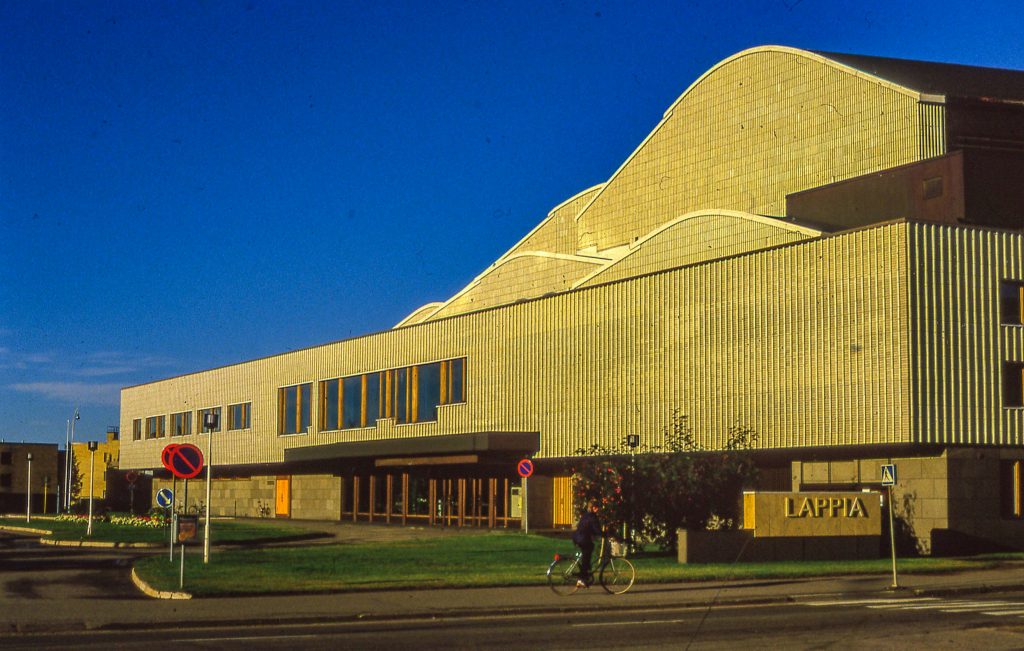Sidetrips in Finland in 1985
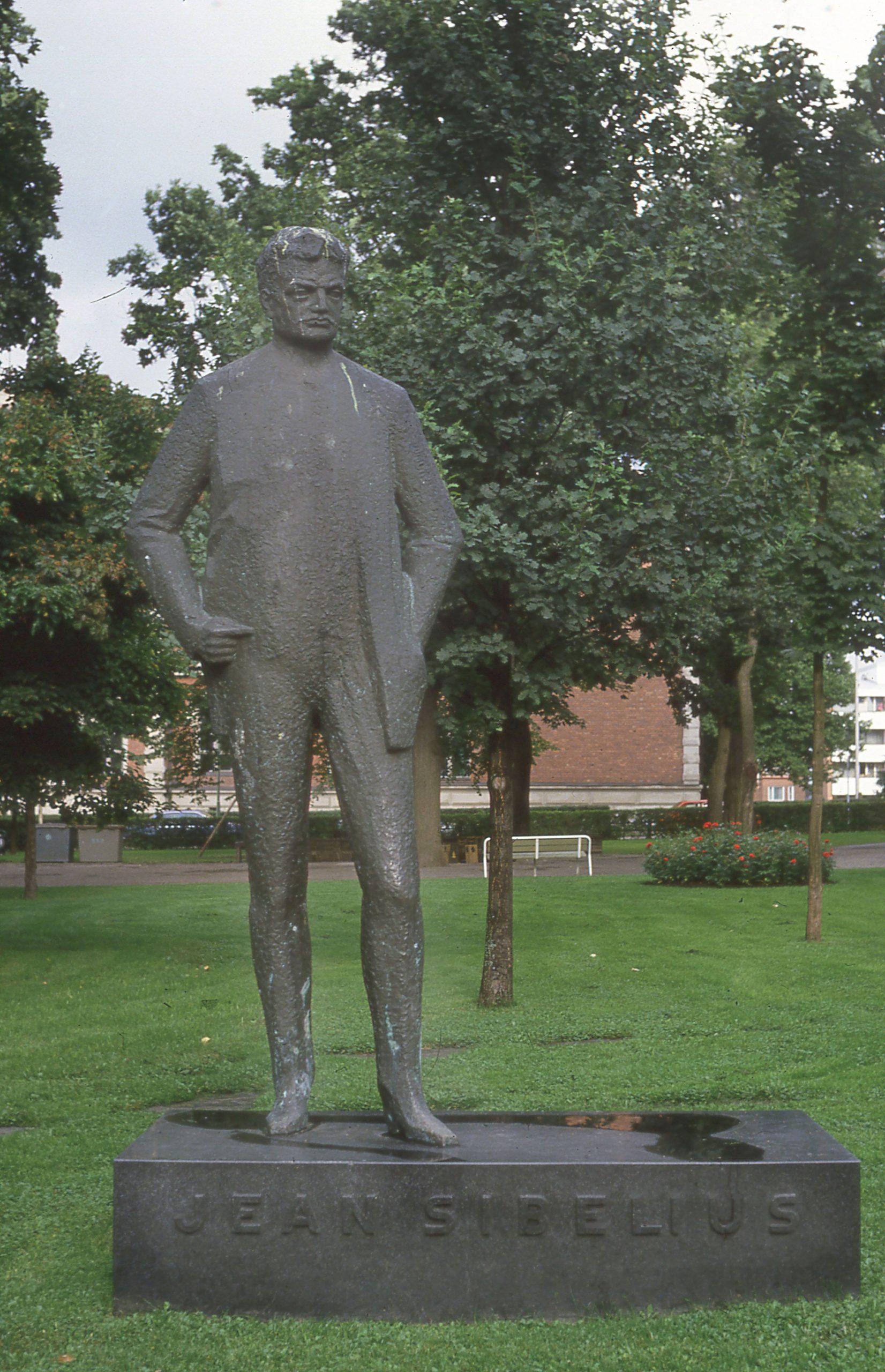
Today’s post is the third (of three) concerning my 1985 trip to Finland. If you missed the first two posts, you can still find them. The first concerns the weaving of the Montana Horses Tapestry which lives in the lobby of the University of Montana’s Performing Arts/Radio-Television Building. That was the reason I went to Finland in the first place. While in Finland, I spent most of my time in Helsinki, and one week ago, I wrote about Walking Around Helsinki. I did not, however, spend all my time in the nation’s capital. Today I’ll talk about my sidetrips in Finland in 1985.
Sidetrips
My Finnish host, Eeva Pinomaa, asked what I wanted to see and/or do while in Finland. I gave her a short list, but mentioned that I really wanted to visit Rovaniemi. She was incredulous. “Why would you want to go there?” she asked. Rovaniemi is the administrative capital of Finnish Lapland, and lies dangerously close to the Arctic Circle. As I explained to Eeva, imaginary lines govern our lives. I doubted I’d ever be closer to this particular line. Outside of Helsinki, it would be one of my sidetrips in Finland in 1985.
Finland has an excellent rail service, one originally built by the Russians. Train tracks cover the country and you can ride easily between any two given locations. When I was there, you could buy a FinnRail Pass for $60 which allowed unlimited rides for two weeks. This was perfect for me. I bought my pass and made my first side trip.
Turku (or in Swedish, Åbo)
Turku (Åbo) lies 94 miles northwest of Helsinki where the Aura River flows into the sea. Directly opposite Stockholm, Turku was the capital of Swedish Finland and was the country’s largest city into the 19th Century. I have no idea why I decided to go there, except that it was an easy day-trip with my rail pass. It was my pleasure to learn that the local museum was having an exhibit of Axeli Gallen-Kallela prints based on the Kalevala. Getting to see Gallen-Kallela’s work made this particular one of my sidetrips in Finland in 1985 well worthwhile.
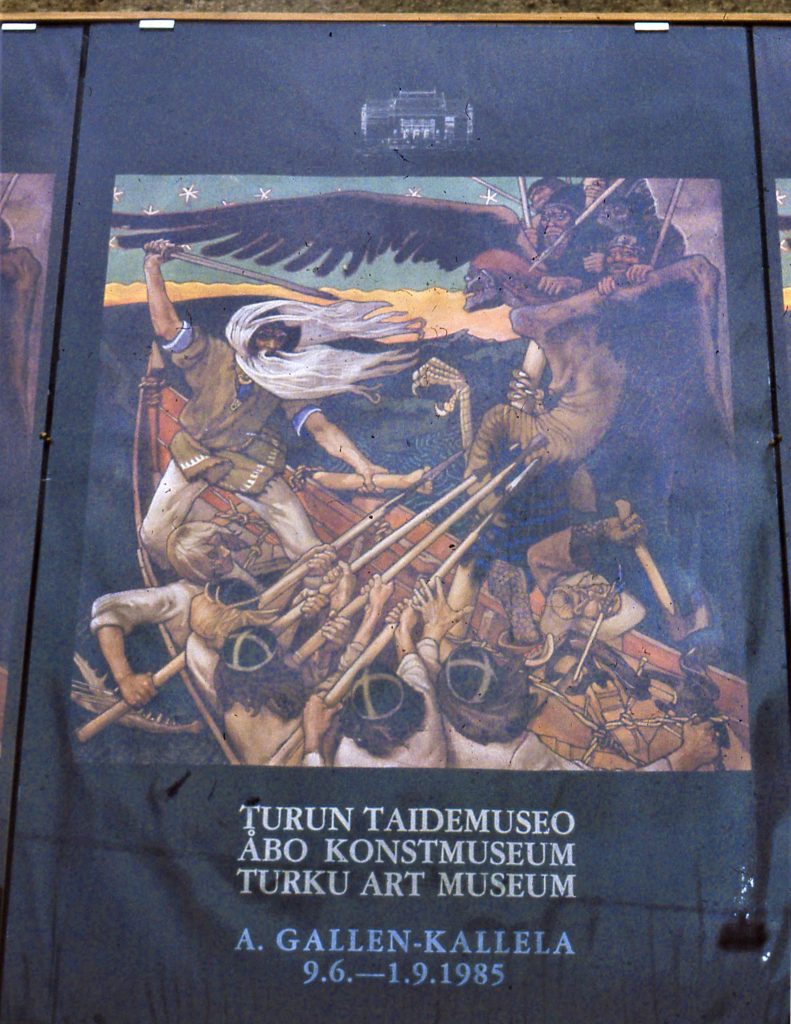
Axeli Gallen-Kallela Exhibit Poster
Turku Art Museum
After visiting the museum, I wandered through Market Square where I took last week’s Flowers photo. Facing the square was a large church. Only now have I learned that the church was Turku’s Orthodox Church, commissioned by Czar Nicholas I in 1838. Dedicated to the Empress Alexandra, Martyr, the church was completed in 1845 and has served the Orthodox community of Turku ever since. I’m sure it’s just a coincidence that the Czarina was named Alexandra. The church is dedicated is Diocletian’s wife who converted to Christianity and was martyred in the 3rd Century C.E.
Hämeenlinna
I went to Helsinki as a representative of the University of Montana’s School of Fine Arts, as I explained in my post two weeks ago. Also, I went as a weaver. Eeva was very gracious in setting me up to meet other weavers. This gave me a chance to see how the craft/art flourished in Finland. One of the places she recommended was the Wetterhof, a school in Hämeenlinna, one of the larger cities in inland Finland. I’m not sure I realized it at the time, but Jean Sibelius claimed the city as his home town. I captured the image of his statue in the city park just a short distance from the Wetterhof .
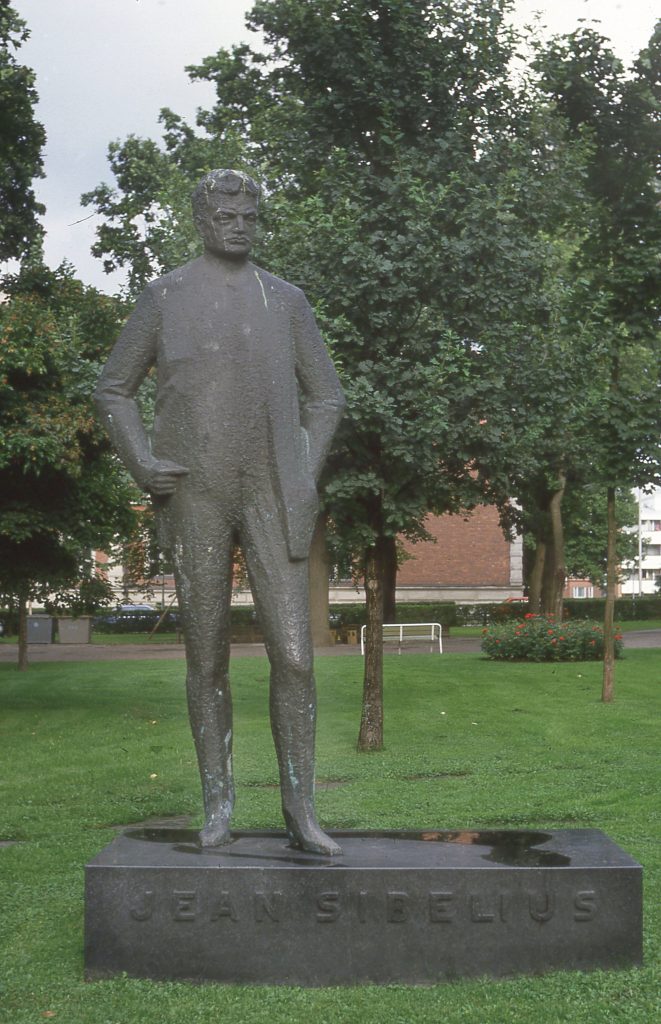
and the Wetterhof
In 1885, Fredrika Wetterhof established a school for girls, aiming to teach them the various crafts that every well educated woman needed. By 1985, when I visited during the school’s 100th anniversary year, Wetterhof had become an institution drawing students from all around the world. In another life, I would have loved taking classes there. In addition to classes in all the yarn arts (weaving, knitting, crocheting), the Wetterhof taught design and marketing.
A full course of study took a student from the early stages of craft, through the design and implementation of a major work of art. The school had an extensive library of craft work, and expected students to raid granny’s closet when they were home on break. The aim was to bring something traditional back for the School’s collections. I’m not sure if they would have wanted my grandmother’s quilts, nor would I have been happy to turn those over. Hämeenlinna was one of my sidetrips in Finland in 1985 because there was no real need to get off the train there.
Continuing on from Hämeenlinna, I spent the night on a northbound train. Last week’s Guest Site of the Day is a Finniish blog titled “Is There a Little Finn in You?” One of the things the writer notes is that a Finn will not bother you if he finds you in his rail seat. That was certainly not my experience. The car was almost empty. Plenty of seating to go around. What they hadn’t told me (or that I hadn’t understood) was that my FinnRail Pass gave me a ticket, but did not assign me a seat. VR, Finland’s rail system, had assigned the seats. A very upset Finn awakened me in the middle of the night demanding that I vacate his seat immediately! He could easily have found another seat, but no, he was in 3B and so I would have to move. Move I did.
Rovaniemi and Finnish Lapland
Early the next morning, my train deposited me in Rovaniemi. The administrative capital of Finnish Lapland, Rovaniemi is a short city-bus ride away from the Arctic Circle. The Kemijoki, or Kemi River, flows through the center of town. Finland’s longest river, the Kemijoki flows out of the borderlands near Russia, crossing the country to empty into the Gulf of Bothnia. The river produces hydroelectric power, and one of its dams is at Rovaniemi. Rovaniemi, or rather the Arctic Circle, was top on my list of sidetrips in Finland in 1985.
During World War II, Finland aligned with Germany, figuring that would be safer than aligning themselves with the Soviet Union. Eventually, the Finns kicked the Germans out, and the Nazi troops left, heading north into Norway and burning everything behind them. As a result, Rovaniemi, a modern city, has been almost completely rebuilt after the War. Lappia Hall, Lapland’s premier theatre, is one example of the new look of the city. Designed by Alvar Aalto, it was the last building completed before Aalto’s death in 1976.
Santa Claus’s Hometown
I walked around Rovaniemi, crossing the Kemijoki and finding both the Lutheran and the Orthodox churches. I also found the crafts center, a fixture in apparently every Finnish city. And then I jumped on a city bus and found myself at the Arctic Circle. Now I knew why Eeva had been nonplussed at my desire to visit the city. The Finns have turned the Arctic Circle into a tourist trap.
Just behind the sign noting the Arctic Circle in six languages, there is a group of buildings, the official home of Santa Claus. In addition to a pen filled with live reindeer, there is a sled full of wrapped presents, and a large Christmas tree. There’s a little voice in the back of my head saying that Kenny and Dolly filmed a Christmas special here, but I cannot find anything about that on line.

Oulu, on the Gulf of Bothnia
It is roughly 131 miles from Rovaniemi to Oulu, and then another 418 miles from Oulu to Helsinki. I have no idea why I decided to disembark at Oulu. The train also passed through Seinäjoki and Tampere on its way south. But Oulu is Finland’s fourth largest city, home of the Air Guitar World Championships. (Is that even a thing? Of course it is.) I consider this one of my sidetrips in Finland in 1985 because I could have just stayed on the train, returning directly from Rovaniemi to Helsinki.
Located on the Gulf of Bothnia, Oulu offers a wide variety of recreational activities. It has the largest bikeway system in Finland, according to the city’s website. It also has some fascinating old buildings along the waterfront. I captured last week’s Classic Car of the Day in Oulu, a British Leyland Princess 1800 HL from the late 1970s. Also, I found this street scene, showing a variety of building styles on just one block–not to mention the English language “home made souvenirs” sign on the side of one building.
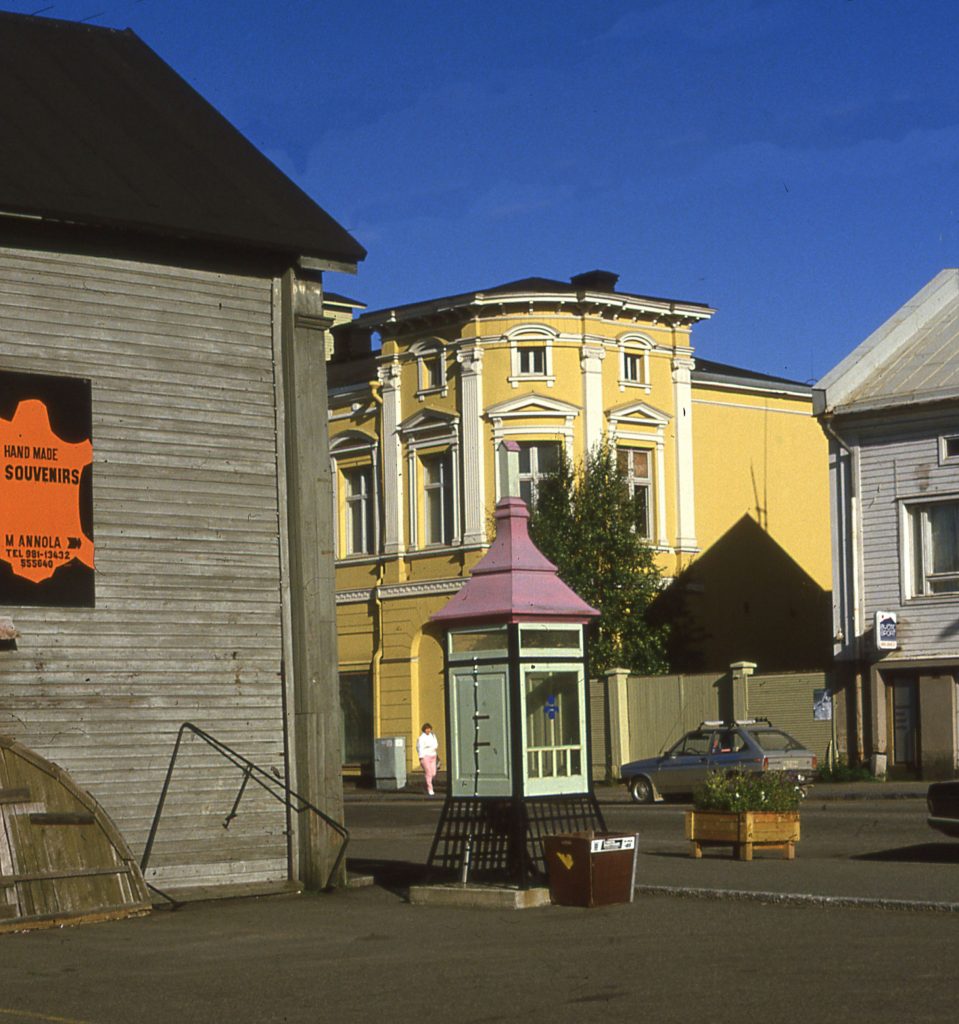
And yes, that is another Puhelin
Farewell to Finland
Once back in Helsinki, I did more sightseeing and enjoyed the hospitality of my host Eeva. I enjoyed my sidetrips in Finland in 1985, and there are more I wish I could have taken. On September 23rd, I headed back to the airport and flew home, again on FinnAir, but business class this time. Would I go back to Finland? In a heartbeat. But in the meantime, there are other places I want to visit.
You’ll note that most of my “of the day” pages have connections to Finland. The Recipe of the Day is Finnish Style Mojakka–a beef and vegetable soup that is a standard in Finnish homes. I’m not quite sure why the All Recipes folk consider it typically Finnish. In my experience, Finnish dishes all have cucumber and dill, neither of which appears in this recipe. That said, I’m sure I could adapt this recipe easily to the Instant Pot™.
The Video of the Day is another piece by Sibelius, the tone poem Valse Triste. Herbert von Karajan conducts, but the clip does not make clear which orchestra the maestro stands before. Valse Triste, Opus 44, No. 1, came to life as one of a series of pieces Sibelius wrote for his brother-in-law Arvid Järnefelt‘s 1903 play Kuolema (Death). The piece stands on its own, however, and is one of Sibelius’ best-loved works.
The Guest Site of the Day comes from the Lapland Welcome website, and is a collection of videos of the Northern Lights (Aurora Borealis) in what Lapland Welcome calls Anthony’s Blog.
Tomorrow’s post is all mysterious. Or not. I’ll be tackling the genre Cozy Mysteries. Just what makes a mystery “cozy” and do men ever write them? Stay tuned.
TTFN
![]()

